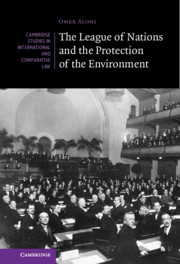Book contents
- The League of Nations and the Protection of the Environment
- Cambridge Studies in International and Comparative Law: 159
- The League of Nations and the Protection of the Environment
- Copyright page
- Contents
- Acknowledgments
- Introduction
- 1 Fighting Pollution Made by Humankind
- 2 The League of Nations and the Whaling Dilemma
- 3 Sanitation, Spreading Diseases, and Environmental Concerns: The League of Nations’ Campaign for Rural Hygiene
- 4 Raw Materials, the Timber Crisis, and Fears of Deforestation during the Interwar Period
- 5 Evaluating the Environmental Regime of the League of Nations: Comparative Discussion
- Conclusion
- Bibliography
- Index
- Cambridge Studies in International and Comparative Law
4 - Raw Materials, the Timber Crisis, and Fears of Deforestation during the Interwar Period
Published online by Cambridge University Press: 30 April 2021
- The League of Nations and the Protection of the Environment
- Cambridge Studies in International and Comparative Law: 159
- The League of Nations and the Protection of the Environment
- Copyright page
- Contents
- Acknowledgments
- Introduction
- 1 Fighting Pollution Made by Humankind
- 2 The League of Nations and the Whaling Dilemma
- 3 Sanitation, Spreading Diseases, and Environmental Concerns: The League of Nations’ Campaign for Rural Hygiene
- 4 Raw Materials, the Timber Crisis, and Fears of Deforestation during the Interwar Period
- 5 Evaluating the Environmental Regime of the League of Nations: Comparative Discussion
- Conclusion
- Bibliography
- Index
- Cambridge Studies in International and Comparative Law
Summary
The chapter uncovers the problem of timber following the Great Depression, and the increasing concerns of spreading deforestation around the world.
The Kingdom of the Forests gained particular attention during the interwar period. International bodies were interested in coordinating the production and supply of different raw materials to the international market, both in regular times and during crises. Immediately after the Great War, the League became interested in timber in particular. When the Great Depression started to affect international commerce, timber production was at stake as well. Accusations against a dumping policy of the Soviet Union have been heard too. This alleged policy applied pressure of its own and put other national timber industries at risk. The League wished to support these industries and encouraged the development of an international regime of mutual cooperation between exporting and importing countries.
With the merging of economic and industrial threads, environmental considerations were woven into the plot, coloring the dilemma with urgent calls to restrict forest harvest in order to stop deforestation from expanding. In the late 1930s, different voices started to advocate for the protection of trees and forests, and encouraged the League to fight back against deforestation.
These dimensions added another layer to the economic incentives and industrial interests surrounding the timber issue.
- Type
- Chapter
- Information
- The League of Nations and the Protection of the Environment , pp. 248 - 290Publisher: Cambridge University PressPrint publication year: 2021

